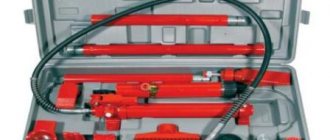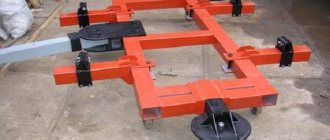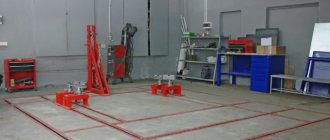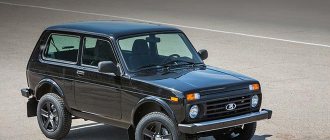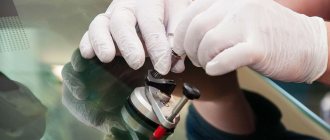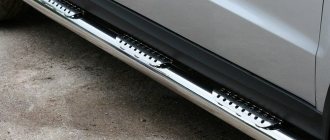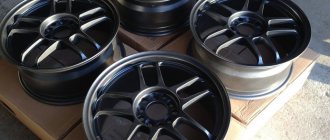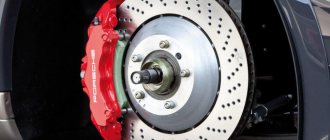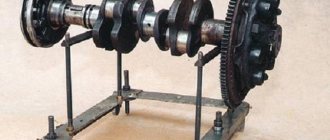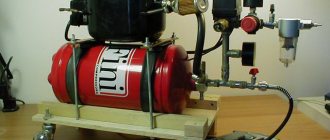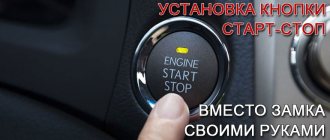We are talking about a device used when performing car body repair work. Such equipment allows you to correct its serious damage, change the size and configuration of some elements. The desired result is achieved through the use of multidirectional forces acting on a well-secured machine. Factory equipment is quite expensive, but it is much cheaper to make a bench for body repair yourself.
How the equipment works
The operating principle is the same for all devices. To restore the geometry of the body, it is fixed to any one or several sections of the slipway. Then the car mechanic, using a traction device and applying force using hydraulic devices, pulls out the deformed elements. If you make a slipway in the garage with your own hands, then it is, as a rule, a simple system that has one exhaust mechanism. There are several of them in factory equipment.
Engine tilter price
In principle, making a tilter for an engine with your own hands, the drawings and designs of which are posted on the page, is quite simple. Another thing is how useful it will be and how justified the use of garage space for its placement will be. Be that as it may, the equipment is very useful and functional, easy to manufacture and inexpensive in materials.
The price of a branded, factory-made tilting berth for passenger car engines will be at least 8 thousand rubles, and if you work hard and make a tilting crane with your own hands, you can save 20-25 thousand.
Types of slipways
There are four types of structures in total, each of which is used in certain conditions. Some types of equipment can be made independently. How are the stocks used today characterized?
Rolling tackles
They differ in their ability to be used to restore the body of a wide variety of cars. The devices available on the slipway allow you to fix the car without flanging the thresholds. Rolling equipment is compact, so it can be used in limited space - that is, it makes sense to make a slipway for body repair with your own hands to install it in the garage. The disadvantage of this equipment is that it cannot be used in the presence of distortions and changes in the geometry of the body.
Floor-standing
It assumes the presence of a rail along which retractable devices move. This design helps to carry out repairs of varying complexity, since the mechanisms move to any point on the slipway. Advantages of floor equipment:
- relatively low cost;
- operational installation;
- small footprint;
- ease of manufacture: you can make a floor stand for body repairs with your own hands;
- if necessary, you can remove the retractable devices and use the floor (the rails are on the same level with it) to place equipment or other purposes.
The downside is the inconvenience of taking measurements of individual body elements and its overall geometry.
Frame
It uses a metal frame on which the machine is secured with chains. Despite the fact that such stocks are used when correcting damage that is not too severe, the frame equipment is structurally more complex. The body is fixed at the required height and in the required position using clamps, and the deformed part is straightened by chains connected to a hydraulic power device.
To simplify lifting, auto frame stocks are often used in conjunction with scissor lifts. Advantages of these designs:
- access to the car underbody and various elements located below;
- Possibility of performing bodywork at different heights.
This is interesting: The theory and operating principle of Ibadullaev’s engine: 3 new provisions in the theory of internal combustion engines
Frame stocks do not take up much space, but they cannot be used to correct serious deformations, since the number of exhaust points is small. Therefore, it makes sense to use such structures during straightening and other simple damage.
Stages of manufacturing a slipway
The most popular are platform or frame designs. This is due to the ease of their manufacture, compact dimensions and relatively large functionality. Finding suitable drawings on the Internet today is not difficult. The best option is to measure the finished factory slipway and focus on its design. The main requirement here is the dimensions, which must correspond to the area of the workshop or garage. The recommended dimensions of the slipway are 4.5 × 1.85 m. Externally, this is a structure where one frame is inserted into another.
Required tools and materials
You will need a welding machine, a hydraulic device, an angle grinder, a drill with drills, a spray gun or paint brushes. Materials you need to purchase:
- profile pipe 40×80 mm (calculate the length in accordance with the drawing, taking into account the jumpers) with a thickness of 4 mm;
- metal for making scarves (thickness 4 mm);
- clamping devices (you can buy factory ones, but if this is not possible, then how to make them yourself will be described below);
- bolts, nuts;
- primer;
- regular or powder paint.
Frame making
First, the outer frame is welded from the profile, then the inner frame is attached to the finished structure. It is necessary to boil from above and below, turning the structure over. Don't forget to use gusset reinforcements at the corners of the structure to increase its rigidity. If you have doubts about the strength of the frame, weld a couple of cross beams in the middle. When the frame is ready, legs must be attached to it from below to adjust the horizontal position of the device. To do this, you can use 15 cm long bolts and 24 cm nuts, which are welded at the corners of the structure. If you wish, install wheels instead of hardware - you will get a mobile slipway. This makes sense if you have a perfectly flat floor or if you place the structure on rails that are in a strictly horizontal position.
Devices for fastening the body to the slipway
If it is not possible to purchase ready-made clamping clamps, then you can make them yourself from railway platforms, through which the rails are attached to the sleepers. Cut each of them in half and weld metal onto the inside, which you can use a grinder to cut into diamonds. Leave the outer side as is, so that when installed on the car sills, their outer side is not damaged. Weld a 4 mm thick plate onto the inner part. This is necessary so that the clamping part evenly fixes the threshold and does not warp.
Making stands, or paws, and upper clamps
You will need steel 1 cm thick. Cut rectangles 200 mm wide and 350 mm long. Weld vertical posts 300 mm high to the resulting platforms; do not forget about the triangular reinforcing struts made of the same metal. To make upper clamps 200 - 250 mm long, it is best to use 1.5 cm thick fragments from KAMAZ springs. You need to burn holes in them for the mounting bolts.
This is interesting: Tuning Lexusu LX/GX470 with photos
As the latter, use hardware that secures a cylinder head with a diameter of 16 mm. These are quite durable products that do not allow threads to break. Weld 12 mm reinforcement from the edges - it will guarantee that there are no distortions when fixing the body.
Welding clamps
Align the frame strictly with the level to ensure it is horizontal. Further:
- attach the vertical posts to the frame using bolts and nuts;
- Use a level to set the height: the paws should be on it;
- Focusing on it, weld the clamping clamps.
The last stage is cleaning the structure from rust, treating it with a primer and then painting it.
Installation of rack and pulling devices
Here you can use factory hydraulic devices or a homemade mechanism. In any case, the power should be 1.5 - 2 tons. To attach the pulling structures, use an overlay made of a channel and installed on the frame of the slipway. So that the pulling mechanism and chains can be placed at any point, drill holes in the frame along the entire perimeter of the structure.
If you prefer a DIY rack design, it is better to use a tower unit. Although it is heavier than other varieties, it provides uniform traction throughout the entire height.
Such a rack can be placed in close proximity to the body, while the power cylinder does not interfere with operation (the rod comes out from the rear).
Using a standard hydraulic pump is not the best solution. It is much more reliable to make such a unit from a jack with a lifting capacity of 8 tons. You will have to upgrade the central cylinder by replacing it with a suitable tube. This is necessary to increase the volume of liquid poured by 300 - 400 ml. Make a breather in the upper part of the jack near the fitting (you can use a grease fitting bent at 90 degrees). And to make it more convenient to work, instead of the bypass bolt, which requires a key, install a “butterfly” that can be turned by hand.
Body clamps and their varieties
Clamp plate from Likota
Modern equipment for car body finishing is represented by various platform and floor-mounted machines and systems that easily eliminate damage and deformation of metal components. Body clamps play an important role in carrying out this type of work.
The role of clamps
ATTENTION! A completely simple way to reduce fuel consumption has been found! Don't believe me? An auto mechanic with 15 years of experience also didn’t believe it until he tried it. And now he saves 35,000 rubles a year on gasoline! Read more"
The role of body clamps is to create pulling and pressing forces in the process of pulling the car body. If the slipway effectively corrects deformations by pulling out potholes in the body, then without special clamps it is simply a useless thing.
Indeed, fixation and gripping is done using good clamps, usually on 4 sides. Almost everything depends on the reliability of the fixing moment. For this reason, it is important for a bodyworker to be able to select the correct clamps.
Some pile machines are equipped with mobile type clamps. They move without restrictions, giving easy access to all starting points of the metal frame, straightening it in any direction.
Clamps from the manufacturer Likota
Let's look at the most popular clamp options:
- Standard clamps for body repair are usually sold at a price of 4-5 thousand rubles. They weigh no more than 2 kilograms;
- Body Clamp 2/5 Ton. It features a narrow grip and the ability to stretch in one or two directions. Despite this versatility, it costs less than a standard clamp - 4,000 rubles. Withstands a maximum load of 2-5 tons. At the same time, in the forward direction – 5000 kg, and in the lateral direction – 2000 kg;
- Body clamp 5 ton with 120mm working width with one direction. Approximate cost: 5,000 rubles. The clamp weighs 3 kilograms and can withstand up to 5 tons in the forward direction;
- A clamp of 3-5 tons, allowing stretching in 3 directions. Approximate cost: 6,000 rubles. Direct direction – 5000 kg, side – 3000 kg each. The clamp weight is a little over 3 kg. The working width is 120 mm;
- A plate for traction forces costs 2.8 thousand rubles. Easily screwed to the body through special holes. The deformed section of the body is pulled out using a hydraulic pump or other tools. The plate weighs no more than 1.7 kg;
- Extraction device, hook costing 2000 rubles. Weighs about 1 kg and is used in body repair as a hook;
- A C-shaped clamp that can withstand 4 tons and costs 8.5 thousand rubles. Capable of working in 4 directions. Weighs a little over 5 kg;
- Clamp hook 4/5 ton. The price for this clamp is about 11-12 thousand rubles. The component weighs 12 kilograms and includes several additional accessories, such as stops, adapter, clamp, latch, etc.;
- Plate clamp for aligning car doors. It costs about 3 thousand rubles, weighs 2.2 kg. Easily attaches to the car door pillar, and then uses hydraulics to straighten the surface of the body element;
- 3 ton large jaw clamp. The cost of the clamp is 3000 rubles. Functions in one direction, weighs just over 2.3 kg;
- A body clamp with a long spout costs 2-3 thousand rubles. Withstands up to 2 tons, functioning in one direction. The design is made in a “flat” design, which facilitates access to hard-to-reach places;
- Double chain clamp for 2.5 thousand rubles. Weighs 1.4 kg;
- A C-shaped clamp that can withstand 5 tons, costs 6-6.5 thousand rubles. Weighs a little more than 3 kg;
- Body mini clamp 2/3 ton (2 directions). The cost of the clamp is 2.7 thousand rubles. The clamp weighs more than 1 kg. Direct direction - 3000 kg, side direction - 2000 kg.
Clamps from AIST
Universal clamp from Stork
Now, for comparison, let’s look at clamps from the manufacturer Aist:
- Retractable hook 5-ton, price 1.8 thousand rubles. Has a working width of 80 mm. Designed for chains and effective fixation of the brace to the body;
- Door pillar straightening plates 2-ton. The cost of clamps of this type is 2.7 thousand rubles. Ideally fixed to the surface of the car body;
- Plate bracket, an excellent option for stretching a deformed body. Withstands up to 3 tons when used with chains. Fixation is carried out using a screw. The cost of the plate is 2.7 thousand rubles;
- 2-way clamp that holds 3/2 ton. Used for body straightening. Makes it possible to pull metal in the forward direction with a force of up to 3 tons, in the lateral direction - up to 2 tons;
- A 5-ton clamp for body work from the Aist company, priced at 2.9 thousand rubles, is very functional. It works in only one direction, the width of the jaws is 45 mm;
- 2-ton clamp for body work, priced at 2.9 thousand rubles. The ideal flat design makes it easy to work in confined spaces. Functions in one direction;
- The grip, priced at 3 thousand rubles, is a very convenient tool for carrying out various work on the body;
- A pincer-like 5-ton body clamp, priced at 3.4 thousand rubles. The width of the jaws is 40 mm.
Clamps and grips from Stanzani
Mini gripper from the manufacturer Stanzani
Another well-known manufacturer in Russia offers the following models of clamps for body straightening:
- C55 is a multi-purpose kit used for most door hinge work. It makes it possible to exert force on the hinges very effectively;
- C 121 is a special gripper for stretching with a force of up to 6 tons;
- Plate C123 for body work with effective properties. It has several holes;
- C126 – Picolo clamp is a small grip equipped with a durable ring. Withstands force up to 4 tons;
- A set of clamps for MacPherson struts with universal properties. You can effectively straighten the racks without disassembling by combining the set with hooks;
- Self-clamping 6-ton screw clamp for body stretching C 128;
- Efficient 10 ton self-clamping screw clamp C 134 100 mm;
- Floating grip for stretching C 135 with an eye, allowing you to stretch the body at any angle with a force of 10 tons;
- 4-ton flat-lipped gripper C 146, allowing deep insertion.
Watch a video about clamps and their use in body repair
The above clamps and grips are effectively used for straightening the body. Moreover, they can be used with different equipment, both with a slipway and with a jack, for example.
Extensions, inserts and clamps create optimal conditions for manipulation. It is imperative to pay great attention to safety when working.
If chains are used during the work, the straightening angle should be exactly perpendicular to the curved area of the body.
The body is also straightened using a square. The latter is fixed on a stand or on the garage floor, again, exactly opposite the damaged area of the body.
Learn more about body editing from video and photo materials. Read interesting articles on the topic of body repair on our website.
Tired of paying fines? There is an exit!
Forget about fines from cameras! An absolutely legal new product - Traffic Police Camera Jammer, hides your license plates from the cameras that are installed in all cities. More details at the link.
- Absolutely legal (Article 12.2);
- Hides from photo and video recording;
- Suitable for all cars;
- Works through the cigarette lighter connector;
- Does not cause interference to radios and cell phones.
